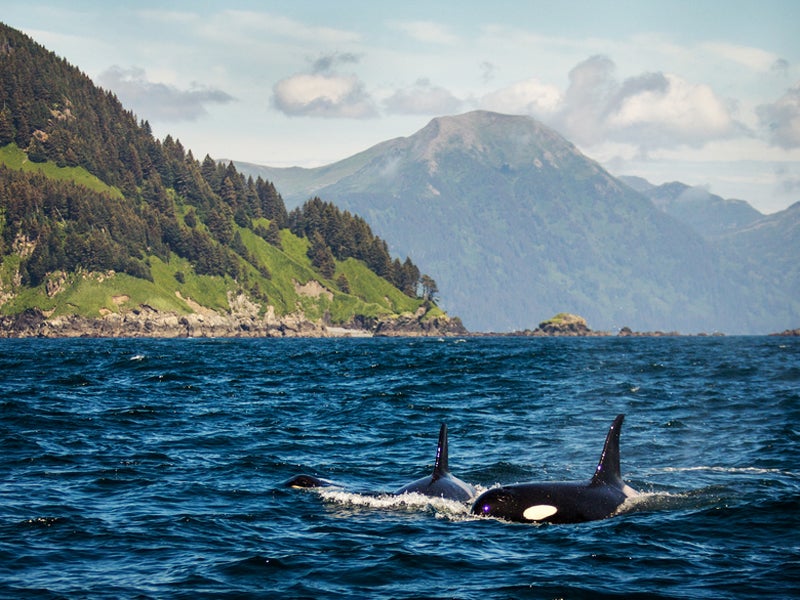Save the Salmon To Save the Whales
Saving iconic Pacific Northwest killer whales means saving their much smaller counterparts.

This page was published 9 years ago. Find the latest on Earthjustice’s work.
In the Pacific Northwest, native coastal tribes have an adage rooted in age-old myths: no fish, no blackfish. The integral connection between orca whales and salmon has been understood since long before Europeans arrived to the region. Now, scientists are also highlighting this important link as they look to understand why whale species are in peril.
In February, the National Oceanic and Atmospheric Administration (NOAA) included Southern Resident killer whales, which swim off the coasts of Oregon and Washington, on its list of the eight most endangered species in the nation. Most recent population estimates suggest that there are roughly 83 remaining whales, a number that, in part, reflects the scarce supply of their preferred prey, Chinook salmon.
According to NOAA, recovery of the Southern Resident orcas depends on the availability of these large salmon, which make up more than 80 percent of the killer whales’ diet. Southern Residents’ survival and birth rates are correlated with the coastal abundance of Chinook salmon.
Chinook salmon runs up and down the West Coast were protected by the Endangered Species Act starting in 1989. In 2005, Southern Resident orcas earned a spot on the same list. According to the EPA, both climate change and human-caused habitat destruction have contributed to the steep decline in Chinook salmon populations in recent years.
Chinook salmon spawn in freshwater streams and migrate as juveniles downstream to the ocean to grow and mature. However, man-made dams hinder migration and even block access to and from spawning areas, making it more difficult for the species to survive and reproduce.
Salmon migration is also being threatened by climate change; even small shifts in water temperature can affect the species’ migration patterns and survival. What’s more, increased ocean temperatures and altered ocean salinity (saltiness) can affect salmon survival rates during their first few months at sea.
Salmon are also threatened by high levels of chemical contamination from lead, mercury and polychlorinated biphenyls (PCBs). These contaminants are then transferred to Southern Resident killer whales when they eat the salmon. According to a study by researchers at the Canadian government’s Institute of Ocean Sciences, these whales are among the most contaminated wild animals in the world. In fact, they are up to 6.6 times more contaminated with these toxic chemicals than Northern Resident orcas, which feed on salmon in more remote parts of British Columbia.
High levels of PCBs in whales may hinder population recovery by making the whales more susceptible to infectious diseases, reducing their reproductive capacity and impeding their normal growth and development. The effects of these and other toxic chemicals are exacerbated when salmon are scarce and the whales are forced to metabolize their blubber—where these chemicals are stored—for energy.
The current salmon crisis threatens both Southern Resident whales and the multimillion dollar commercial whale watching industry in the Pacific Northwest. In Washington state alone, the whale watching industry is worth an estimated 70 million dollars annually.
In May, Earthjustice secured a victory for salmon in the Pacific Northwest and the Columbia River Basin after the presiding judge rejected the federal government’s plan to manage salmon runs on the grounds that the plan did not adequately protect the endangered species. However, significant gains still need to be made to ensure the survival of salmon, and in turn, the survival of Southern Resident whales. Our current Chinook salmon restoration efforts in the Columbia Basin focus on removal and modification of four outdated dams on the Snake River that obstruct salmon migration to and from pristine Chinook spawning grounds in Idaho. There are also ongoing efforts to protect and restore salmon habitat in many places along the West Coast.
This year marks the 10th annual Orca Awareness Month in Washington state, an effort to draw attention to the plight of Southern Resident killer whales. This year also marks the first time Orca Awareness Month has expanded outside of the state—It has also received state-wide recognition in Oregon and British Columbia. Among the partnering organizations for Orca Awareness Month is the Orca Salmon Alliance, of which Earthjustice is a member. The alliance works to educate the public about threats to killer whales and to promote Chinook salmon protection and restoration. Together, the Orca Salmon Alliance and its partnering members are calling for the federal government to prioritize salmon recovery in an effort to help restore killer whale populations.
Without fish, there can be no blackfish—the adage rings truer now than ever, reminding us that to save Southern Resident killer whales, we must first save Chinook salmon.